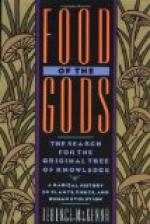The name of “Soconosco” cocoa is still a guarantee of excellent quality. This district in Guatemala was in bygone days so noted for its cacao that the whole crop was monopolized for the use of the Spanish Court. In Central America, as in other countries, the Spaniards gathered more solid riches from the cacao than from the gold mines they hoped to discover.
[Illustration—Black and White Plate: A Scene in the Maracas Valley, Trinidad.]
British and Dutch Guiana produced but little cacao as long as sugar realized high prices, but in comparatively recent years it has been more extensively planted, and the crops from the lowlands at the mouths of the great South American rivers have been very heavy.
In French Guiana cacao was scarcely cultivated until about 1734, when a forest of it was discovered on a branch of the Yari, which flows into the Amazon. From this forest seeds were gathered, and plantations were laid out in Cayenne.
The cacao of Para in Brazil differs from all other growths; the bean is much smaller and rounder, and is elongated, but when well cured it is mild, and has a very pleasant flavour, highly valued by manufacturers. Bahia produces large quantities of cacao, formerly of an inferior quality, owing to careless cultivation and indiscriminate mixing of all that was brought from the interior, some of it wild and uncured. But now this state of things is being improved, and the good quality of “fermented” Bahian cacao is fully recognised.
A little cacao is grown in the low-lying parts of Rio Janeiro, but it is not to be met with further south than this. The part of Florida which borders the Gulf of Mexico and the southern part of Louisiana mark the northerly limit of its natural growth.[20] A traveller in Louisiana in 1796 speaks of the cacao-tree among others as “covering with delightful shade the shores of the Mississippi,” and on the banks of the Alatamaha in Georgia, but it is not cultivated so far north.
At the present day the West India Islands rival the South American Continent in providing cocoa from the New World. Trinidad has for more than a century deservedly claimed to be the first of these cocoa-producing islands. As far back as the sixteenth century the Spaniards who first colonized the island were interested in the cultivation of cacao. In the year 1780 a French gentleman residing in the neighbouring island of Grenada visited Trinidad, and gave such a glowing account of its fertility that agriculturists from France and elsewhere flocked to the colony, and ever since this date it has maintained a high standard of agricultural advance. The names of the cacao estates at the present day are nearly all Spanish or French, and throughout the British occupation of more than a hundred years the old families have in many cases held the same lands.[21]
[Illustration—Colour Plate: MAP OF TRINIDAD.]
The oldest estates in the island lie in the northern valleys of Santz Cruz, Maracas, and Arima; but cultivation has been considerably extended in the Montserrat and Naparima districts, and more recently in almost every part of the island reached by the extension of the railway and the coasting steamboat. The Trinidad bean is the largest and finest flavoured, and commands a higher price on the market than any other from the West Indies.




